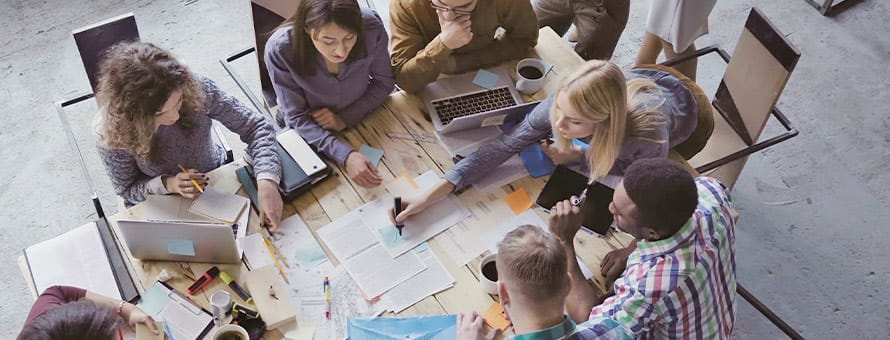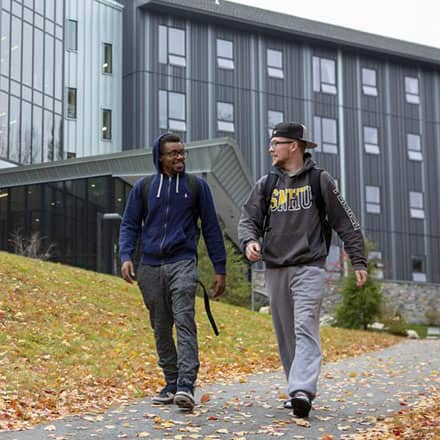The Importance of Critical Thinking Skills, For Students and Ourselves

Critical thinking is a vital, yet often neglected, skill. In higher education, Chris Griffiths, author of “The Creative Thinking Handbook,” noted in a TLNT blog article that critical thinking is “the ability to think clearly and independently about a subject or problem ... (and the) consideration of multiple perspectives, the checking of biases, and a detailed understanding of relevant context.” Put more simply, it means objective analysis, but we often form judgments without that all-important objective evaluation.
Employers on the Southern New Hampshire University (SNHU) Social Sciences Advisory Board tell us that they need people with critical thinking skills, but applicants often lack this ability. Their desire for critical thinkers is reflected in current research showing that critical thinking is one skill that cannot be taken over by artificial intelligence (AI) and that higher education must take a proactive role in preparing students with this skill.
What Skills Do Critical Thinkers Have?
According to, Dr. Norman Herr, a professor of science education, critical thinking skills can be boiled down to the following key elements:
- Identification of premises and conclusions — Break arguments down into logical statements
- Clarification of arguments — Identify ambiguity in these stated assertions
- Establishment of facts — Search for contradictions to determine if an argument or theory is complete and reasonable
- Evaluation of logic — Use inductive or deductive reasoning to decide if conclusions drawn are adequately supported
- Final evaluation — Weigh the arguments against the evidence presented
When translated to the professional world, the National Association of Colleges and Employers (NACE) identifies critical thinking as a top skill (NACE PDF Source). NACE said that students should be ready to demonstrate it by inclusive reasoning and judgement to make decisions and solve problems; analyzing and communicating information from multiple sources with awareness of biases that could impact outcomes; and communicating that information accurately to diverse groups of stakeholders.
As educators, we must teach our students those critical thinking skills and practice them ourselves to objectively analyze an onslaught of information. Ideas, especially plausible-sounding philosophies, should be challenged and put through rigorous credibility tests.
Red Flags for Unreliable Information
The School Library Journal lists four types of information that should raise red flags when we’re watching the news, reading social media, or at any point in our everyday lives when we’re confronted with something purported to be “fact:”
- Fake news, which refers to purported news that is demonstrably untrue.
- Misinformation, which is spread by those who don’t realize that it’s false or only partially true.
- Disinformation, which is deliberately spread by people who know that it’s not accurate and who want to spread a false message.
- Propaganda, which is information that is spread with a specific agenda. It may or may not be false, but it’s intended to get an emotional reaction.
These information types may overlap, especially with the extinction of local news sources. As of 2023, there were only 1,213 daily local newspapers left in the U.S., and they continue to disappear at a rate of two each week, according to a report from The State of Local News Project. The report also notes that there are over 200 counties with no local print, broadcast, or digital news outlets and over 1,500 with only one. This lack of access to local news is overwhelmingly found in high poverty areas, often with predominantly Black, Hispanic or Native-American populations.
This provides opportunities for biased websites to fill the gap; misinformation tracker NewsGuard said that there are almost 1,300 websites positioning themselves as local news while pushing political agendas.

Updated Tools to Support Critical Thinking
SNHU and other colleges and universities across the U.S. must use updated tools to help their students think critically about the information they consume. Currently, many institutions of higher learning fail to teach students how to identify misinformation sources.
AI acts as a cautionary example of the way in which the landscape can transform quickly and dramatically. Generative AI has the ability to converse on any topic and write in the style of anything from an essay to a news article with an air of authority. Griffiths noted that, while it mimics something written via independent thought, it’s regurgitating a mishmash of existing ideas drawn from its training data. It incorporates any biases in that data and even “hallucinates,” providing output as factual when it’s partially or entirely untrue.
Bad actors can leverage AI technology to create written, graphic and audio content that masquerades as real news. One relatively harmless example is the AI-generated photos that supposedly show Katy Perry attending the 2024 Met Gala. Although she was not there, the ruse was so convincing that it even fooled her mother. While the Perry pictures did not cause widespread harm, they show how easily bad actors can convince others of a deepfake’s authenticity. Videos can also be created or manipulated easily to create fake news stories like a supposed Tucker Carlson interview with a Pfizer official about a new FDA-approved diabetes cure. The “story” was actually an ad for an unproven dietary supplement.
As educators in institutions of higher education, we must afford learners as many opportunities as possible to hone their critical thinking skills when interacting with instructors and fellow students.
Greg Lukianoff and Johnathan Haidt, authors of "The Coddling of the American Mind," contend that “one of the most brilliant features of universities is that, when they are working properly, they are communities of scholars who cancel out one another’s confirmation biases.”
Without exploring opposing viewpoints, students may fall prey to confirmation bias, further cementing ideas that they already believe to be true. Being inclusive when it comes to viewpoint diversity is indispensable for avoiding these echo chambers that circumvent having one’s ideas challenged.
How to Think Critically
As we teach our students the importance of critical thinking, how do we equip them to sift through the onslaught of information they encounter every day, both personally and in their educational pursuits? And how do we do the same for ourselves?
Here are four critical thinking examples that anyone can apply when evaluating information:
 Consider Vested Interest
Consider Vested Interest
Consider whether the person who wrote or is sharing the information has any vested interest in doing so. For example, a writer may have a degree and professional experience that gives them expertise to write an article on specific communication techniques.
Be aware that the writer’s credibility can be affected by outside interests. These include being paid to write a book with a certain viewpoint, giving paid seminars, affiliation with certain organizations or anything else that creates a financial or personal interest in promoting a specific perspective.
 Examine Biases
Examine Biases
Consider the venue in which the person is sharing the information. Newscasts and newspapers once were slanted more toward neutrality, although there was never an era when bias was completely absent. The 19th century even had its own version of clickbait in the form of yellow journalism.
Today, it’s getting more difficult for those with critical thinking skills to find unbiased sources. Use websites like AllSides, which rates major sites on their leanings.
 Read Beyond Clickbait Headlines
Read Beyond Clickbait Headlines
Websites create headlines to generate traffic and ad revenue, not to support critical thinking or give accurate information. Too many people go by what the headline says without reading more deeply, even though media misrepresentation of studies is rampant.
Often, the information contained within the article is not accurately represented in the headline. Sometimes there’s even a direct contradiction, or the publication is focusing on one single study that may mean nothing because other studies have contradictory results.
 Fact-Check Information
Fact-Check Information
Use Snopes, Fact Check, and other fact-checking websites that examines viral memes and news stories for truthfulness. Ironically, Snopes itself has been the victim of misinformation campaigns designed to discredit its efforts to promote the importance of critical thinking.
Why is Critical Thinking so Important?
Misinformation, if not addressed, easily turns into disinformation when it’s readily shared by students, individuals and groups that may know it’s wrong. They may continue to intentionally spread it to cast doubt or stir divisiveness. Students listen to their peers, and the more critical thinking is addressed in a course, the more we prepare students not to fall into the misinformation trap.
Courtney Brown and Sherrish Holland, of the Center for the Professional Education of Teachers, argue that for educators, the challenge is now far more about how they need to inform their students to interpret and assess the information they come across and not simply how to gain access to it. The term “fake news” is used to discredit anyone trying to clarify fact from fiction. Fake news is a cover for some people when they are being deliberately deceptive.
As educators become clearer about the distinction, it can be better communicated to students.
Teaching Students to Think Critically
Anyone in a teaching position should point their students toward reliable references. For example, at SNHU, instructors can send students to databases in the Shapiro Library. For other materials, they should teach them to evaluate their integrity based on the four elements of critical thinking.
Is the premise legitimate or is it clickbait? Are the arguments in the article supported by evidence? Do the facts paint a reasonable picture, or are there contradictions? Is the article based on logic, or is it designed to draw in readers by misrepresenting its content? Is it hosted on a biased site, and do its authors have connections that could cause bias? Does it pass a fact check as a final evaluation?
Instructors can also incorporate these elements into announcements, discussion posts and feedback. For example, they can post two articles with differing viewpoints on the week’s material. For each, they can break down the publication’s possible slant, the way in which any research-based material is presented, and the author’s credentials. This demonstrates the different ways in which similar material can be presented, depending on the source and authors’ affiliations and biases.
Anyone Can Promote Critical Thinking
Even if you don’t teach, use those points in conversations to help others hone their critical thinking skills. If someone shares misinformation with you, don’t be combative. Instead, use probing statements and questions designed to spark their critical thinking.
Here are some examples:
- “That’s very interesting. Do you think the person they’re quoting might be letting his business interests color what he’s saying?”
- “I know that sometimes the media oversimplifies research. I wonder who funded that study and if that’s influencing what they’re saying.”
Of course, you need to adapt to the situation and to make what you say sound organic and conversational, but the core idea remains the same. Inspire the other person to use critical thinking skills. Give them reasons to look more deeply into the topic instead of blindly accepting information.
American cultural anthropologist Margaret Mead said, “Children must be taught how to think, not what to think.” Her sentiment is true for learners of any age, which makes it crucial for educators to maintain sharp critical thinking skills and pass them along to students to support them in their careers and in everyday life.
A degree can change your life. Choose your program from 200+ SNHU degrees that can take you where you want to go.

Dr. Nickolas Dominello is the senior associate dean on the social sciences team at Southern New Hampshire University. He joined SNHU in 2014, served as a lead psychology faculty member, was promoted to associate dean in 2018 and then to senior associate dean in 2023. Dominello completed his doctoral training at Capella University in 2013, becoming a PhD in Psychology. He also has a Master of Arts in Education at the secondary level, and he has over 20 years of experience working as an educator.

Dr. Barbara Lesniak is the executive director of Social Sciences at Southern New Hampshire University. She started at SNHU as an adjunct in 2012, and her previous roles included associate dean of psychology and senior dean. Her experience outside of academia includes 15 years designing and delivering classroom and web-based courses in the corporate world and providing face-to-face and online counseling services. She specialized in helping online clients in acute crisis situations. Lesniak has a PsyD in Psychology and, as a lifelong learner, she earned an MFA and MS in Marketing at SNHU and is currently working on an MS in Organizational Leadership.

Dr. Tom MacCarty is an associate dean on the social sciences team and oversees the MS in Psychology program at Southern New Hampshire University. He received his PhD in Industrial/Organizational Psychology from Northcentral University. He also holds a Certificate of Advanced Graduate Studies in School Psychology and a Master of Arts Degree in Counseling Psychology from Norwich University. MacCarty can be found on LinkedIn.
Explore more content like this article

What Are the Requirements for a Master’s Degree? Know Before You Apply

What Master's Degree Should I Get?

What is an Accelerated Master's Program?
About Southern New Hampshire University

SNHU is a nonprofit, accredited university with a mission to make high-quality education more accessible and affordable for everyone.
Founded in 1932, and online since 1995, we’ve helped countless students reach their goals with flexible, career-focused programs. Our 300-acre campus in Manchester, NH is home to over 3,000 students, and we serve over 135,000 students online. Visit our about SNHU page to learn more about our mission, accreditations, leadership team, national recognitions and awards.

